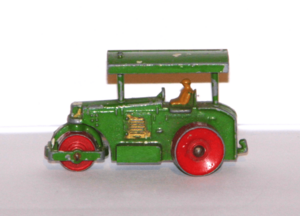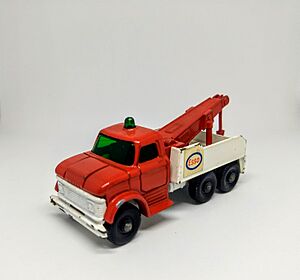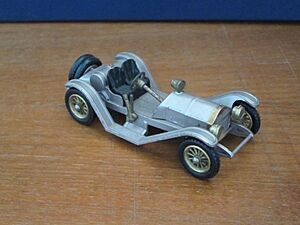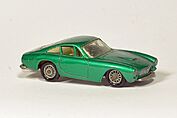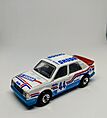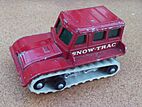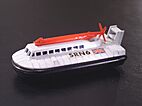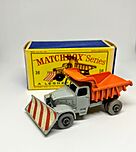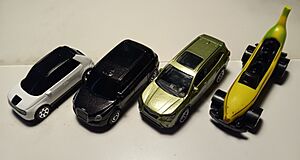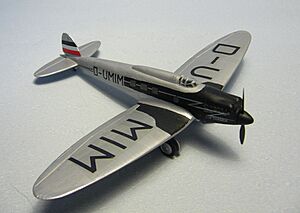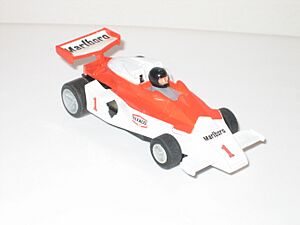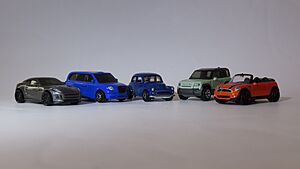Matchbox (brand) facts for kids
 |
|
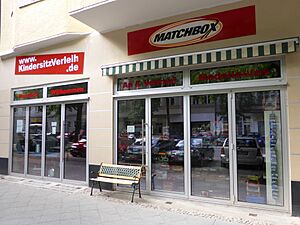
Speciality store for Matchbox collectibles
in Berlin, Germany, 2015 |
|
| Type | Toys, scale model vehicles |
|---|---|
| Owner | Mattel (since 1997) |
| Country | United Kingdom |
| Introduced | 9 July 1953 |
| Related brands | Powertrack |
| Markets | Worldwide |
| Previous owners |
|
| Registered as a trademark in | United States |
Matchbox is a famous toy brand that started in 1953. It was created by a British company called Lesney Products. Today, Mattel, Inc. owns Matchbox, having bought the brand in 1997. The name "Matchbox" came about because the first toy cars were sold in small boxes, just like matchboxes. Over time, the brand grew to include many different toys. These included larger metal models, plastic model kits, slot car racing toys, and action figures.
In the 1980s, Matchbox started using plastic and cardboard "blister packs" for its toys, similar to other toy car brands like Hot Wheels. However, by the 2000s, the classic box packaging returned for collectors. This happened for special editions, like the 35th Anniversary of Superfast in 2004 and the 50th Anniversary in 2019. Today, Matchbox sells scale model plastic and metal vehicles, along with toy garages.
Contents
The Story of Matchbox Toys
How Matchbox Began: Lesney and the First Cars
The Matchbox name began in 1953 with a British company called Lesney Products. This company was known for making metal toys. It was founded by John W. "Jack" Odell, Leslie Charles Smith, and Rodney Smith. The name "Lesney" was a mix of Leslie and Rodney's first names.
Their first big success was a model of Queen Elizabeth II's coronation coach, selling over a million copies. Jack Odell then created a toy for his daughter. Her school only allowed toys that could fit inside a matchbox. So, Odell made a tiny version of a green and red road roller. This small toy became the very first in the 1-75 miniature series. A dump truck and a cement mixer soon joined it. These three toys started the huge success of the Matchbox series. The company decided to sell these models in boxes that looked like matchboxes, which gave the series its name.
More models were added throughout the 1950s, including cars like the MG Midget TD and Ford Zodiac. The collection also became more international, with models from Volkswagen and Citroën. The small size of Matchbox cars helped them find a special place in the toy market. Their low price made them affordable for many, and "Matchbox" even became a common word for small toy cars, no matter the brand.
Growing Bigger: The 1-75 Series and More
In its early years, the 1-75 series was sold by a company called Moko. The boxes from that time even said "A Moko Lesney." In 1959, Lesney became fully independent from Moko. This led to a period of great growth for the company.
Early Matchbox models were made entirely of metal and did not have windows or interiors. They were usually about 2 inches (5 cm) long. By 1968, Matchbox was the best-selling brand of small metal toy cars worldwide. By then, the average model had plastic windows, interiors, and tires. Many also had working parts and were about 3 inches (7 cm) long. Some even had steering. The range included many different vehicles, like trucks, buses, tractors, and motorcycles.
Matchbox also introduced other toy lines. The Models of Yesteryear, started in 1956, featured classic vehicles from older times. These were often about 3.5 to 4 inches long. Accessories Packs were added in 1956, offering items like petrol pumps and garages. Major Packs, which were larger models, often construction vehicles, came out in 1957. The King Size series of bigger trucks and tractors was added in 1960. By 1968, Major Packs had joined the King Size range.
Facing Challenges and Becoming Superfast
Matchbox mainly focused on its smaller cars. Other toy companies tried to compete, but none were very successful until Mattel introduced its Hot Wheels cars. Hot Wheels had special "racing" wheels that made them super fast. These models were colorful and often featured fantasy vehicles. They were also heavily advertised with race track sets.
Lesney quickly responded to this new competition by creating the Superfast line. This meant updating their 1969 cars with low-friction wheels and new colors. By 1970, the Superfast line was complete, offering fast-rolling cars, trucks, and trailers. They also released racing track sets. From 1970 onwards, new models appeared with wider tires, and older models were updated. The King Size range also got an update, splitting into Super Kings (mostly trucks) and Speed Kings (cars).
By the mid-1970s, Matchbox was strong again in the toy market. They had completed their changes and even added some fantasy vehicles to their line. The 1-75 series also included Rola-Matics, which had moving parts when the vehicle rolled.
Expanding the Matchbox World
To make the most of its renewed popularity, Matchbox introduced several new lines. These included Sky Busters (aircraft models), Battle Kings (military models), Sea Kings (naval models), and Adventure 2000 (science fiction models). The Two Packs series offered a model with a matching trailer.
Unfortunately, some of these new lines, like metallic-painted tanks, did not sell well at first. Later versions of Battle Kings and Sky Busters were painted in more realistic colors and were better received. However, economic problems in England made it hard for the company to make a profit on toys made there.
Only Sky Busters and Two Packs continued for a long time. The Convoy series of large truck-trailers grew out of the Two Packs line and is still around today.
Matchbox also started to connect with collectors in the 1970s. They attended collector meetings and shared information. This led to creating special models just for collectors, like a black Yesteryear Ford Model T. This success showed the company that making special, limited-edition models was very popular and profitable. This led to more "promotional" models, which were made for specific companies or countries, often featuring their logos. This part of the business grew quickly, leading to models made for collectors rather than just children.
New Owners and a Fresh Start
Even though Matchbox toys were selling well, the company faced financial problems in the United Kingdom. In June 1982, Lesney went bankrupt. The "Matchbox" brand name, along with some tools and molds, was sold to Universal Toys and David Yeh. Jack Odell, one of the founders, continued to make similar toys under the Lledo brand (Odell spelled backward).
Matchbox International Ltd. was formed, and production moved to Macau. During this time, Matchbox also bought the rights to the famous Dinky brand. New models were created, and the Dinky Collection was born. Matchbox also started developing the "Matchbox Collectibles" idea for adult collectors.
Because of high labor costs, Universal moved its toy production to mainland China in 1984. The first Matchbox toys with "China" on their base were made in 1985. Production later moved to the Philippines, Taiwan, and Thailand.
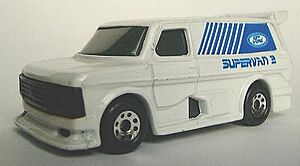
In 1992, Universal sold Matchbox to Tyco Toys. Then, in 1997, Mattel bought Tyco's toy division. This brought Matchbox and its old rival, Hot Wheels, under the same company.
Many Matchbox collectors were worried when Mattel bought the brand. They feared that Mattel would change Matchbox to be more like Hot Wheels. However, Mattel promised that Matchbox would continue to make realistic vehicles, while Hot Wheels would focus on fantasy cars. To show this, some realistic Hot Wheels Caterpillar models were even rebranded as Matchbox.
In 2002, for its 50th anniversary, Sky Busters aircraft models returned. In 2003, Mattel tried a new direction for Matchbox with "Hero City" and fantasy vehicles. Collectors were very unhappy, and the toys did not sell well. The line was quickly stopped.
The next year, a new team at Matchbox decided to go back to the brand's roots. They started making realistic, detailed models, mostly based on real cars. The classic Matchbox logo returned, showing a commitment to the original idea.
Mattel also launched a new 1-75 series to celebrate the "35th Anniversary of Superfast." These models came in special packaging that looked like the old Superfast boxes from 1970. These limited-edition models were very popular. More Superfast series were released in 2005, 2006, 2019, and 2020. The Superfast series was replaced in 2021 by the Matchbox Collector line. These collector-focused vehicles have special features like opening parts and rubber tires.
In 2019, Matchbox launched the Moving Parts line. These vehicles have opening features like hoods and doors. Some models in this series are based on older Lesney designs.
Matchbox Goes Green
On April 15, 2021, Matchbox announced a big change. They planned to make a 1:64 scale Tesla Roadster in 2022 using 99% recycled materials. This was part of a plan to make the brand more environmentally friendly. Matchbox promised that all their cars and packaging would be made from 100% recycled materials by 2030. The first Matchbox cars with recycled packaging were the Power Grabs assortment.
Matchbox also released an EV-themed pack with electric cars like a Nissan Leaf and BMW i3. They also added EV charging stations to two playsets. This was done to encourage kids to think about the environment.
Matchbox Toy Lines
The "1-75" Series: A Classic Collection
Lesney slowly increased the number of models in its main Matchbox Series from three in 1953 to 75 in 1960. The "1-75" range stayed at 75 models for almost 40 years. When a new model was released, an older one was stopped, and its number was reused. This meant that toy store displays only needed space for 75 models.
Later, under Mattel, the regular US Matchbox series grew to 100 models in 1999, then went back to 75 in 2001. It increased again to 100 models in 2008, then to 120 in 2012, and 125 in 2016. These changes did not happen in all countries.
The actual number of the 1-75 series was cast onto the baseplates of the models starting in the mid-1950s. This stopped when Universal took over. Today, a different casting number (like MB687) is on the baseplate, and the 1-75 series number is printed on the packaging.
Sizes of Matchbox Models
Matchbox cars are mainly made in two sizes:
- The smaller models (the "regular size" 1-75 series) are often called 1:64 scale. They are about 2.5-3 inches (6.5-7.5 centimeters) long. However, their actual scale can vary a lot.
- Matchbox also made models in about 1:43 scale, sometimes called "King Size." These were later named Speed Kings or Super Kings. They are about 3.5-4 inches (9-10 centimeters) long. This was similar to the size of Corgi or Dinky toys. Matchbox designers liked this larger size because it allowed for more detail. These 1:43 models are still made, but they are mostly sold to collectors, not as toys.
Plastic Model Kits
Matchbox started its own plastic model kit division in the UK around 1972-1973. They focused on 1:72 scale military aircraft and 1:76 military vehicles. These kits had a unique look, with parts made in two or three colors, unlike other brands that used only one color. The boxes were also colorful and had clear windows so you could see the parts inside. Matchbox military vehicle kits even came with a small display base.
Later, Matchbox bought the AMT Corporation, an American model kit maker. AMT's line of 1:25 scale cars and trucks continued. Matchbox kits were well-made, but some thought they lacked fine detail compared to other models. The company eventually stopped making model kits.
Original Matchbox model kits are now highly sought after by collectors.
Types of Kits
Matchbox produced kits in various scales:
- 1:72, 1:48, 1:32 scale aircraft
- 1:32, 1:76 scale military vehicles
- 1:76 scale soldiers
- 1:700 scale ships
- 1:32 scale cars
- 1:12 scale motorcycles
Today, the Matchbox model kit molds are owned by Revell Germany. Revell sometimes re-releases these old Matchbox kits under their own name.
Other Cool Matchbox Products
Over the years, Matchbox has made many other interesting products. They published collector catalogs each year starting in 1957. They also made collector cases for kids to store their 1-75 vehicles. From 1957 to the 1970s, they offered toy garages and service stations with Esso or BP logos.
Matchbox also created jigsaw puzzles, race track sets, and a clever plastic wall-display system. They even had a slot-car system for regular (non-powered) car models called Matchbox Motorways.
Matchbox Motorways
In the late 1960s, the Arnold Minimobil system from Germany was sold as the Matchbox Motorway in the UK. These sets had hard plastic tracks that looked like concrete roads. Electric motors along the track drove continuous spring loops. Small plastic pins on the bottom of Matchbox vehicles would connect to these springs, pulling the cars along the track.
Slot Cars: Powertrack
In the late 1970s, Matchbox also made slot cars called "Powertrack" or Speedtrack. These cars even had working headlights. Some Powertrack models were also released in the regular Matchbox 1-75 line. Other Powertrack sets included a lane changer and a Race and Chase set with a police car that could jump and make U-turns.
Toy Soldiers
Also in the late 1970s, Matchbox produced a small range of 1:32 and 1:76 Second World War toy soldiers. These sets included British, German, and American infantry. The figures were popular because they were well-made and came with different weapons and poses compared to other brands.
Action Figures
During the 1970s, Matchbox created its own action figure lines. These included Matchbox Fighting Furies (pirate and cowboy figures) and Mobile Action Command (plastic figures with rescue vehicles). From the 1980s, their action figures were often tied to TV shows like Robotech and Voltron. Most of these lines stopped when Matchbox was bought by Tyco.
Video Games
In the 1990s and early 2000s, Matchbox also released several video games based on their toy vehicles. These games featured construction and emergency services (fire, police, ambulance). Gameplay involved action sequences related to the vehicles, like stopping a robbery with a police car in Motor City Patrol. These games were made for various platforms, including Game Boy and NES.
Main Die-Cast Series Overview
Here are some of the main die-cast toy series Matchbox has produced:
- 1-75 (also called the regular series, Superfast series, 75 series)
- Accessories
- Models of Yesteryear
- Major Packs
- King Size (later Super Kings and Speed Kings)
- Scorpions (battery-powered cars)
- Sky Busters (aircraft)
- Two Packs (models with trailers)
- Battle Kings (military models)
- Sea Kings (naval models)
- Adventure 2000 (science fiction models)
- Convoy (trucks)
- Dinky (Matchbox bought the brand in the late 1980s)
- Real Working Rigs (introduced in 2009)
Matchbox also sold Gift Sets, which included models from different ranges. These sets were updated regularly and sometimes included special model variations or extra items.
Collecting Matchbox Models
Collecting Matchbox models is a popular hobby, much like collecting stamps or coins. The value of a Matchbox model depends on a few key things:
- Rarity (how few were made, or how rare a specific version is)
- Condition (how new or worn it looks)
- Popularity of the model
- Packaging (if it still has its original box or blister pack)
Rarity and Different Versions
A model can be rare if only a few were made. This might happen if the mold broke, or if the toy was not popular and was quickly replaced. Sometimes, a model is rare because it's a specific "variation." Variations are small changes made during production. These can be changes in materials, the molds themselves, or the colors used.
For example, early Matchbox models were all metal, even the wheels. But then Lesney switched to plastic wheels, first silver, then grey, then black. So, a model from the 1950s might have four different wheel types, making some versions much rarer than others.
Molds are sometimes changed due to problems or to improve production. These changes can be tiny, making early versions of a model quite rare. Color changes were less common in the past but are now a planned marketing tool. The color of the body, baseplate, interior, and windows can all create different variations.
Older models are generally rarer than newer ones, even if they were produced in similar numbers.
Condition Matters
The better the condition of a model, the more it is worth. Conditions are usually described as: mint (like new), excellent, very good, good, fair, or poor. A "mint" model is worth much more than a model with chipped paint or broken parts. However, the condition must be original. Repainting or repairing a model greatly reduces its value.
The Importance of Packaging
Having the original packaging can significantly increase a model's value. A "mint boxed" model can be worth 50-100% more than a mint model without its box. This depends on the age and condition of the box, and even variations in the box design.
Early boxes, like the "A Moko Lesney" boxes from the 1950s, are extremely valuable today. Even with blister packs, the packaging still plays a role in value.
Popularity's Role
A model's popularity also affects its value. For example, a popular sports car from the 1950s might have sold out quickly. Even if many were made, it might be harder to find in good condition today because kids played with them more. This continued popularity also drives its value up.
Cataloging and Guides
Matchbox collectors' clubs have helped to code and catalog models and their variations. They also provide rough value estimates. Many books have been published by collectors' organizations and authors, describing the different Matchbox ranges and their variations. These books are available in English and other languages.
While many books include price guides, there is no single agreement on the exact monetary value of a model. Prices can change a lot in the collector's market.
Special Editions and Promotions
Regional Issues
By the 1960s, Lesney realized that sales could increase in certain countries by offering models "of their own." For example, for the German market, the #25 Bedford Tanker was changed from its usual yellow and white BP colors to a blue and white Aral version. This was a successful idea and was later expanded to other countries like Australia and Denmark.
For a short time in the 1970s and 1980s, Matchbox also produced or licensed production in other countries. They made some models in Japan and licensed production to groups in Hungary and Bulgaria. These models often had unique color variations that are rare today.
Later, Matchbox decided to make different versions of the 1-75 series for different regions around the world. Today, there are usually ranges for the US and the rest of the world, with some "local" mini-series in certain countries.
Promotional Models
Almost from the start, companies saw the chance to use Matchbox models as advertising. For example, in the 1950s, dairy companies sometimes gave customers the Matchbox #7 Horse-Drawn Milk Float as a thank you.
The first model made specifically for a customer was the "Beales Bealesons" #46 Guy "Pickfords" Removal Van. This special version, made for a shop in southern England, had different colors and decals from the standard model. It became highly sought after by collectors.
The use of London Bus models in the 1970s, especially the Superfast #17 Londoner Bus, greatly increased the number of promotional models. Many companies used this model for advertising. This success led to more models being used for promotions, including larger Yesteryears and Super Kings.
Today, promotional models are still an important part of Matchbox's business. Some are made in very limited numbers, while others are produced in large quantities for special offers.
Matchbox Collectibles
Starting in the Universal era and continuing after Mattel bought the brand, Matchbox began making special series specifically for adult collectors. This idea wasn't new; in the 1960s, Lesney had made gold and silver-plated versions of its Yesteryear series for adults.
Matchbox introduced the "Matchbox Collectibles" name for these special items. These models often had high levels of detail, rubber tires, and "chrome" wheels. They were made in limited quantities and sold at higher prices in stores as "Premiere Collectibles" or "World Class." Other toy companies quickly copied this idea.
Later, Models of Yesteryear, Dinky, and Convoy series were used to create themed collectible "mini-series." The Super Kings range also produced large truck "specials." These were often sold by mail order. Matchbox Collectibles Inc. became a semi-independent part of Matchbox International Ltd. This was very successful, leading to many new, high-quality models. Partnerships with major brands like Texaco and Coca-Cola made the range even more appealing.
However, to pay for the new models, prices kept going up. About three years after Mattel bought Matchbox, the development of the Collectibles range mostly stopped. Some models are still sold through major retailers like Target in the US.
Matchbox in Movies
A live-action film based on the toys is being made by Mattel Films. In 2022, Skydance Media joined the project. On May 7, 2024, Sam Hargrave was hired to direct the film. On September 17, 2024, it was announced that John Cena was cast as the lead. The film is set to be released on Apple TV+. In November, Jessica Biel joined the cast, followed by Sam Richardson, Arturo Castro, Teyonah Parris, and Danai Gurira in December. The movie is expected to come out in fall 2026.
Matchbox Collectors
Matchbox models quickly became popular items to collect. In the late 1960s, the American importer of Lesney toys created the "Matchbox Collectors Club" for younger collectors.
In the 1970s, adult collectors started forming their own clubs to discuss collecting in more detail. They talked about and cataloged variations, organized swap meets, and created new magazines for serious collectors. Like stamps or coins, prices for older and rarer models began to rise. Collecting is not just about the models themselves; anything related to Matchbox, like catalogs or display cases, is also collected.
In the US, two main clubs were formed: NAMC (National Association of Matchbox Collectors) and AIM (American-International Matchbox club). These clubs were central to Matchbox collecting in the US during the 1970s and 1980s. Other clubs, like MICA (Matchbox International Collectors Association) and Matchbox USA, are still active today. Many collectors have also published books showing models, their variations, and price guides.
Matchbox collecting is popular in the UK, Commonwealth countries, and North America.
Sky Busters Series
Matchbox Sky Busters is a line of die-cast model aircraft produced under the Matchbox brand. It was first made by Lesney Products and later by Mattel.
The first Sky Busters were made in 1973 in London, England. In the 1970s, Skybusters competed with other toy airplane brands. Early Skybusters included both military and commercial aircraft models. Airlines like Air France and Lufthansa advertised with Skybusters. Some of the first models were the Learjet, Airbus A300, and Boeing 747.
The Skybusters line returned in 1976. The brand has appeared on and off the market until the 2000s, when Mattel decided to release models every year. Currently, no airlines have direct contracts with Matchbox to produce Skybusters models. The most recent ones include American Airlines, UPS, British Airways, Alaska Airlines, Lufthansa, and DHL. Jetliners are often released under fictional airline names, like Matchbox Airlines.
In 2012, Matchbox Skybusters released a replica of The Bat, an aircraft from the film The Dark Knight Rises.
In 2024, Matchbox announced a partnership with SpaceX to produce models of that company's aircraft. In 2025, Matchbox returned to featuring real airline brands on their Skybusters series, with the release of an American Airlines A320 and a UPS Airlines Boeing 747-400.
See also
 In Spanish: Matchbox (marca) para niños
In Spanish: Matchbox (marca) para niños
- Lesney Products (for the history of Matchbox's parent company)
- Powertrack (for extensive details of Matchbox slot car racing)
- Ring Raiders


